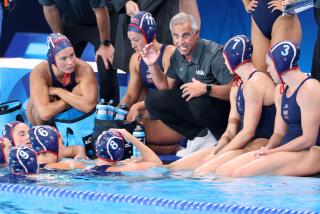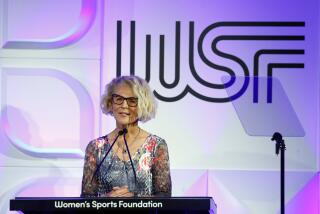Erasing a Line in the Sand
If you just got around to digesting the concept of Shaquille O’Neal calling Kobe Bryant his idol, try swallowing the sound bite of Karch Kiraly referring to Sinjin Smith as his “role model.”
In the world of beach volleyball, this qualifies as a major peace accord. Former teammates at UCLA, on the indoor Olympic team and one-time professional beach partners, Kiraly and Smith spread to opposite sides of the net in the contentious beach volleyball scene.
Kiraly was a major proponent of the Assn. of Volleyball Professionals Tour. Smith spent most of his time with the Federation Internationale de Volleyball, the sport’s international governing body. The two circuits had slightly different rules and had major clashes over the Olympic qualifying process once the sport was adopted for the Atlanta Games in 1996.
Now Kiraly and Smith are unified, doing their part to promote the newly revamped AVP. Partners. Imagine that.
“I think it’s a good thing for the sport for us to be on the same--closer to on the same--page,” Kiraly said. “My focus has really been trying to help build American volleyball, and Sinjin’s focus seems to have been much more worldwide. So he has been rarely playing in this country or rarely doing his promotional activities in this country. I think it will be a healthy thing for this sport to try to get everybody on the same page.”
Smith said, “I always knew that if the sport was going to be successful, we had to be working together as opposed to working against each other. . . .
“If we’re going to build the sport up in this country . . . we’re competing against so many things in this country, you can’t break the sport in two and think you’re going to survive.”
The squabbling caused beach volleyball to drop from the high-paying, high-profile glory days of the early 1990s to a sport with no network television contract and no direction.
It was a huge hit in its Olympic debut in Atlanta. Fans packed the stands in a stadium built around trucked-in sand. A deejay rocked the sound system during the breaks in the action. Fans danced the Macarena (remember, this was 1996).
When Kiraly and Kent Steffes met Smith and Carl Henkel for a berth in the semifinals, it had as strong a political undercurrent as any event after the dissolution of the Soviet Union.
The AVP side was upset because the FIVB rankings were used to determine the entrants--Smith and Henkel cruised in as the top-ranked FIVB members, whereas Kiraly and the AVP side had to qualify through a tournament.
Smith still had issues with the AVP from when the tour suspended him and fined him $75,000 for playing in a 1992 Olympic showcase event that was not sanctioned by the AVP.
“It was a player-run organization, and the guys running the show were the guys I was competing against every weekend,” Smith said. “And, unfortunately for them, I would beat them every weekend. They would look at any way, it seemed like, they would take every opportunity to make Randy [Stoklos, his former playing partner] and my life as difficult as possible.”
The Olympic match itself was a classic--some called it the best beach volleyball match ever--with Kiraly and Steffes advancing to eventually take the gold medal.
Beach volleyball drew sellout crowds to Bondi Beach in Sydney as well (the parade of bikinis nearby didn’t hurt). Again, it came amid political contention. Dain Blanton and Eric Fonoimoana, who wound up winning the gold medal in Sydney, were suspended by the AVP because they hadn’t followed the right procedures to skip an AVP event to participate in an FIVB event to gain Olympic qualifying points.
All of the petty politics must come to an end. That’s one thing Leonard Armato hoped to accomplish when he led a group that purchased the AVP and brought the women’s Beach Volleyball Assn. into the fold. The new AVP Tour kicks off next weekend at Hermosa Beach.
“I made it clear to the players that all of us must settle our past differences and put any differences that we have aside in the interest of growing the sport and growing the asset,” said Armato, who was one of the original founders of the old AVP Tour.
“I sort of appealed to that sensibility in them. My message to the players was, put the sport above yourself. Your own individual interests have to take a back seat.”
Kiraly isn’t crazy about the international rules (including a smaller court, heavier ball and rally-scoring system) that the AVP will use, but he won’t get hung up on it.
Smith is ready to forget the past.
“I’ve never hated Karch, I’ve never had a problem with Karch,” Smith said. “I don’t know where all the issues came from.”
Kiraly is very serious and practical, with a purpose behind everything he says and does--”Mathematical,” Armato called him. Smith is a little more relaxed, but no less a businessman; he owns sports apparel businesses and race horses.
If they want to keep playing volleyball for a living, they need each other and the tour needs them. Not only do Karch Kiraly and Sinjin Smith have cool names (note the alliteration), they also happen to have two of the biggest, most attention-grabbing names in the volleyball world.
But Smith is 44 and Kiraly is 40. How much longer can they play at a competitive level?
“I guess I’ll look to Sinjin to be my role model for that,” Kiraly said. “He’s still playing very good volleyball.”
Kiraly had shoulder surgery last year, but is feeling better now and said he will keep playing as long as he is productive and enjoying himself.
“And if I have neither fun nor a high level of play, then this may be my last year,” he said.
Smith has had five surgeries on his right knee and will see how it holds up.
“It’s day to day, as far as playing goes,” he said. “I’ll stay involved with the sport one way or another.”
When Smith and Kiraly were partners before, it worked fine. They won 21 of 24 matches before they split in 1984. Now they’re united again; still rivals on the sand, but united off it, well aware that they’re stronger when they are together.
*
J.A. Adande can be reached at: [email protected]
More to Read
Go beyond the scoreboard
Get the latest on L.A.'s teams in the daily Sports Report newsletter.
You may occasionally receive promotional content from the Los Angeles Times.






